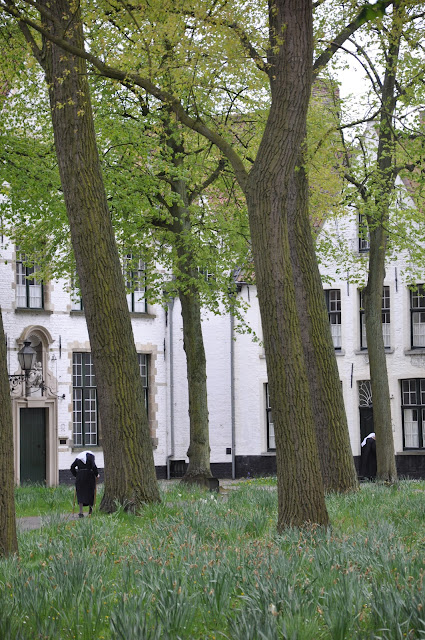In the middle of central Amsterdam, located between the busy pedestrian-only Kalverstraat and the main traffic road of Nieuwezijds Voorburgwal is a cluster of small homes surrounding a garden courtyard that has sheltered women since 1346.
The Begijnhof itself was not a convent, but an almshouse for pious laywomen (begijnen) involved in religious and charitable work, part of an order called The Beguine.
The beguines' ranks began to swell during the Crusades, when so many men took off, never to return, leaving society with an abundance of single women. Later, women widowed by the hazards of overseas trade lived out their days as Beguine. Poor and rich women alike turned their backs on materialism and marriage to live here in Christian poverty. In 1578, when Catholicism was outlawed, the Dutch Reformed Church took over many Catholic charities like this place. The last begijnen died in 1971, but the Begijnhof still provides subsidized housing to single women in need, so their privacy needs to be respected.
There is a statue of one of these charitable sisters in the courtyard:
Photo:
© www.begijnhofamsterdam.nl

Photo:
© Jim Forest

She faces the wooden house at #34 Het Houten Huys, one of only two surviving timber houses in Amsterdam built in 1425. (Timber houses were prohibited from being built after 1452 after a series of disastrous fires.)
The brick-faced Engelse Kerk was the Beguine church until 1607, when it became Anglican. The Pilgrims (strict Protestants fleeing persecution in England), stopped here in tolerant Amsterdam and prayed in this church before the Mayflower carried them to religious freedom in America.
Down Mariastraat away from the high-trafficked tourist sights in Brugge is another charming and restful enclave with low, white-painted gabled houses, most of which date from the 17th and 18th centuries. The houses are set around cobbled walkways shaded by tall trees and a spacious patch of grass.
Brugge's Begijnhof has occupied this same site since 1244, since its founding by Margaret of Constantinople, Countess of Flanders. Its full name is the Prinselijk Begijnhof ten Wihngaarden (Princely Beguinage of the Vineyard) because Philip the Fair, King of France, placed it under royal protection in 1299 (no one can explain the vineyard bit). The Beguines lived pious lives, doing charity work, but they were not nuns and could leave the community to marry. A Liège priest encouraged widows and unmarried women to live in communities to do the pious acts especially caring for the sick. The last of the Beguines died in 1928; the nuns seen here today are Benedictine sisters whose order took over the site in 1930. However, they have adopted the habits once worn by the Beguines.
Thank you for visiting,
A Great Europe Trip Planner
Unless noted, photos were taken by me.
Thank you for visiting,
A Great Europe Trip Planner
Unless noted, photos were taken by me.






No comments:
Post a Comment